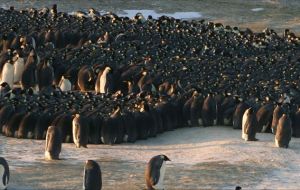MercoPress. South Atlantic News Agency
Penguins’ winter huddle clusters are all the time on motion to keep warm
 The almost imperceptible waves of the huddled penguins were captured in video
The almost imperceptible waves of the huddled penguins were captured in video The mystery of how penguins stay warm while they huddle has been revealed by an international team of scientists. Emperor penguins survive the tough Antarctic winters by forming tightly packed clusters - but scientists have pondered how penguins on the outside stay as cosy as those in the centre.
Now time lapse video shows the birds move in almost imperceptible waves through the group, which over time drastically change its structure.
The footage was recorded during the winter at Dronning Maud Land in the Antarctic, where temperatures can dip to below -45C and winds can reach 180km/h.
During this period, male Emperor penguins pack tightly together not only to keep themselves toasty, but also - thanks to the fact that they are the only vertebrate to breed during the Antarctic winter - to incubate their eggs (the absent females have headed out to sea).
Previously, researchers thought these groups were so tightly packed that any motion would be impossible meaning unlucky penguins at the periphery would be forced to remain there.
Lead author Daniel Zitterbart, a physicist at the University of Erlangen-Nuremberg in Germany, said: “The penguins have to huddle or otherwise they lose energy. But if the huddle is too loose - the penguins freeze, and if your huddle too tight, you can't move at all. Anywhere you want to go, there is another penguin there.”
But cameras, which took an image of a colony every 1.3 seconds over a period of several hours, revealed that the huddle was far from a motionless mass.
Dr Zitterbart explained: “The colony would stay still for most of the time, but every 30-60 seconds one penguin or a group of penguin starts to move - just a little bit.
”This makes the surrounding ones move - and all of a sudden this move throughout the colony is like a wave.”
The coordinated movement through the group was so subtle that in real-time, it was invisible to the naked eye, but over a longer period it had an impact on the colony's structure.
By propelling the tightly packed penguins forward, it allowed smaller huddles to merge into larger ones - allowing for some readjustment of the penguins' positions.
But the footage also revealed that as the wave swept to the front of the group, some penguins there would waddle out of the pack and head to the back.
This means that over several hours, penguins would use the waves to travel through the colony, and get a chance to share the warmth. (BBC).-




Top Comments
Disclaimer & comment rules-

-

Read all commentsI saw this comnclusion on the Attenborough programme Life in the Freezer a couple of years ago.
Jun 04th, 2011 - 11:33 am 0Very interesting but not really news.
Snap - was just about to say the same thing !
Jun 04th, 2011 - 03:05 pm 0Commenting for this story is now closed.
If you have a Facebook account, become a fan and comment on our Facebook Page!